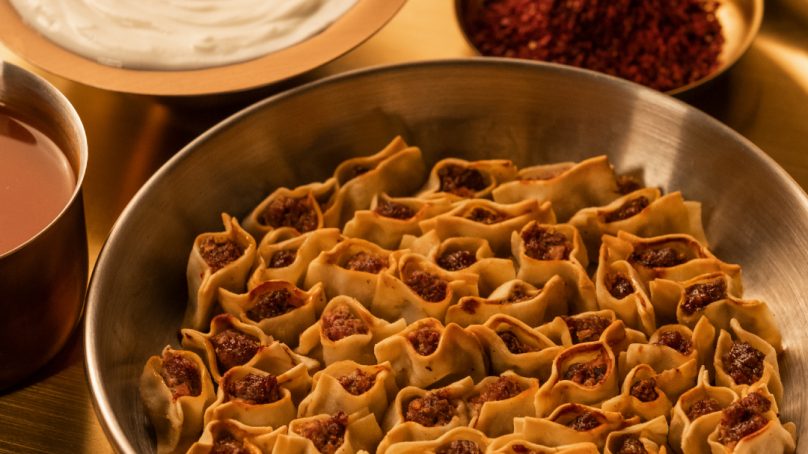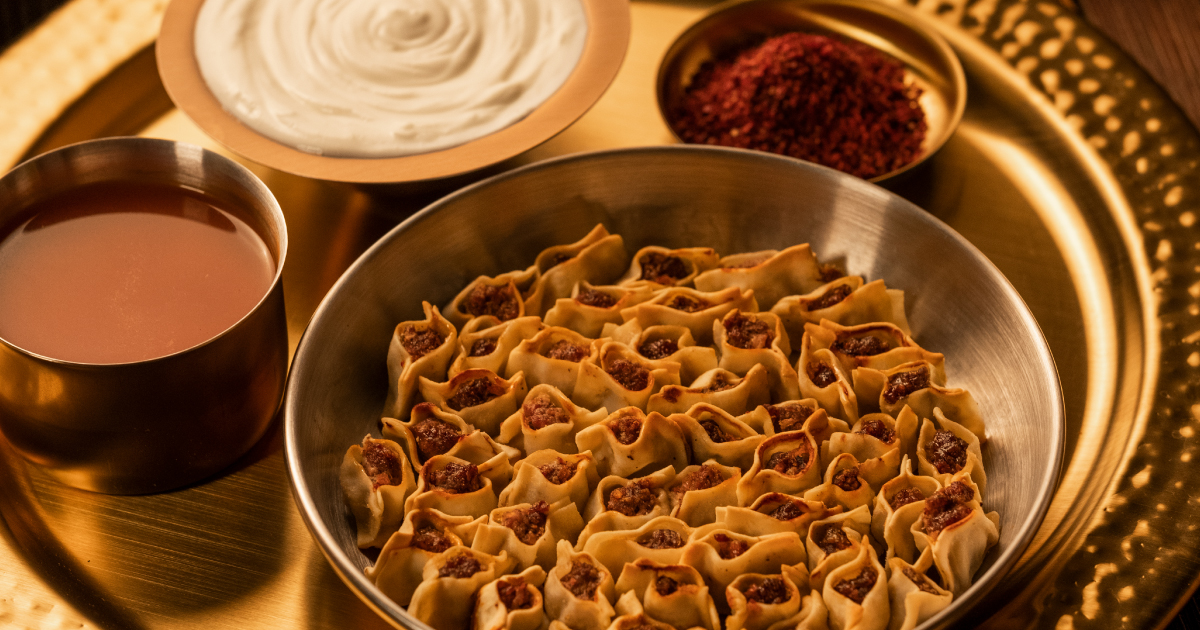

Armenian cuisine distinguishes itself from other culinary traditions through a combination of special ingredients, preparation methods and cultural influences. One hallmark of Armenian cuisine is its use of indigenous ingredients like apricots, pomegranates and walnuts, which impart unique flavors to dishes. Lavash, a thin, soft flatbread, is an essential element of Armenian meals, often used for wrapping or accompanying food. Grilled meats, particularly kebabs, are prevalent, with marination in herbs and spices adding contrasts to flavors. Armenian cuisine also features dolma, where grape or cabbage leaves are stuffed with a blend of minced meat, rice and herbs, then simmered in tomato sauce. While often considered spicy, a more accurate term to describe Armenian cuisine would be aromatic, thanks to the use of Aleppo sweet pepper, which we use to make our pepper powder and pastes, giving the food aroma rather than heat.
A cuisine of contrasts
Armenian cuisine is all about contrasts – of flavors, temperatures, textures and colors. The Middle Eastern influence, due to Armenia’s location, is evident in dishes like kebbe and itch. Rice dishes are flavored with spices and frequently include vegetables, dried fruits or meats. Armenian desserts, such as baklava, merge sweetness with nuttiness. Dried fruits, especially apricots, play a prominent role in both savory and sweet Armenian cuisine. Overall, Armenian cuisine’s uniqueness arises from its special ingredients, bread, grilling traditions, sauces and the fusion of Middle Eastern and local influences, offering a rich and culturally resonant culinary experience.
From north to south
Armenian cuisine exhibits regional variations, with distinct culinary traditions and flavors found across the country. Western Armenia is known for its use of lamb and bulgur wheat, with dishes like keufte (meatballs) and raw meat popular here and the use of aromatic spices like cumin prevalent. In Eastern Armenia, meanwhile, diners will find a strong emphasis on grilled meats, lavash and dairy products. Khorovats – Armenian barbecue – is a signature dish, with dairy-based soups and dishes like matsun (yogurt) also common. The Syunik region, in the south, is known for its use of fresh herbs and greens, with dishes like kchuch (a green herb stew) and spas (a yogurt soup) among the regional specialties. Northern Armenia, or the Lori region, is famous for its dairy products, particularly cheese and its version of matsun, among others, popular here. Overall, these regional differences reflect the diverse geography and history of the Armenian people, resulting in a rich tapestry of flavors and dishes found across various parts of the country and elsewhere, including Artsakh (Nagorno-Karabakh) and among the diaspora, worldwide.
Cultural and social influences
Armenian cuisine is deeply intertwined with the cultural and social fabric of the country, giving it a pivotal role in various aspects of everyday life, from the warm hospitality extended to guests to strong family bonds, cultural identity and celebratory events. Preparing and sharing meals is a communal activity, with family gatherings often revolving around traditional dishes, made with pride by multiple generations, using fresh local produce, from recipes passed down from mother to daughter.
Cooking methods
Traditional Armenian cuisine relies on a range of cooking methods, all of which contribute to the rich and diverse flavors of the dishes. Common traditional cooking methods include grilling (khorovats), which is a popular method for preparing meat varieties such as lamb, beef and pork. The meat is marinated with spices and herbs before being skewered and grilled over an open flame, often on a barbecue. Stewing is ideal for many Armenian dishes, allowing spices to meld and the rich, hearty flavors of chosen meats and vegetables to develop in flavorful broths or sauces. Baking in traditional ovens is also central to Armenian cuisine for a variety of savory and sweet pastries, bread and key dishes like mante (dumplings) and soubeureg (layered pastry and cheeses). Popular dishes like beureg (filled pastries), meanwhile, are deep-fried to achieve a crispy texture.
Flavorsome combinations
Lamb, beef and pork are among the popular meat varieties used in various dishes, with an emphasis on quality and flavor, while fresh herbs ranging from parsley, cilantro and dill to mint are seen as essential for adding freshness and depth of flavor. Go-to vegetables include eggplants, tomatoes, cucumbers and Aleppo peppers, all of which are frequently used in salads and stews, with grains such as bulgur wheat, rice and lentils among the staples that provide the foundation for many dishes. Walnuts and almonds are often incorporated into both savory and sweet dishes, providing a delightful crunch and nutty richness, while cumin, coriander, paprika and black pepper feature on the list of popular spices, alongside sumac, which is used to give dishes a tangy, lemony flavor. Feta and moushallale string cheese are among the dairy products that frequently feature in Armenian dishes, providing them with creaminess and a tang, alongside yogurt and sour cream.
Trending today
Several trends and innovations have influenced Armenian cuisine over the years, including a revival of traditional recipes and interest in preserving them, and cooking methods. In a reflection of global food trends, there has been a growing emphasis on farm-to-table initiatives and sourcing of fresh, seasonal and locally grown produce, supporting small-scale, sustainable farming. The use of healthier ingredients to create lighter and more nutritious versions of Armenian dishes, while ensuring that the authentic flavors are retained, is another trend in evidence. Fusion cuisine has also become popular, driven by a desire to create unique and contemporary Armenian dishes, and modern presentation, as found in upscale restaurants such as Mayrig, alongside innovative desserts which appeal to modern tastes.
Looking ahead, we expect the focus on authenticity in food and the importance diners attach to it to continue. There is much greater awareness today of the part that cuisine can play in maintaining heritage and Armenia is a proud pioneer in this field, with its food celebrated and enjoyed around the world.

Aline Kamakian,
founder and CEO of Fig Holding,
@alinekamakian
figholding.com
















